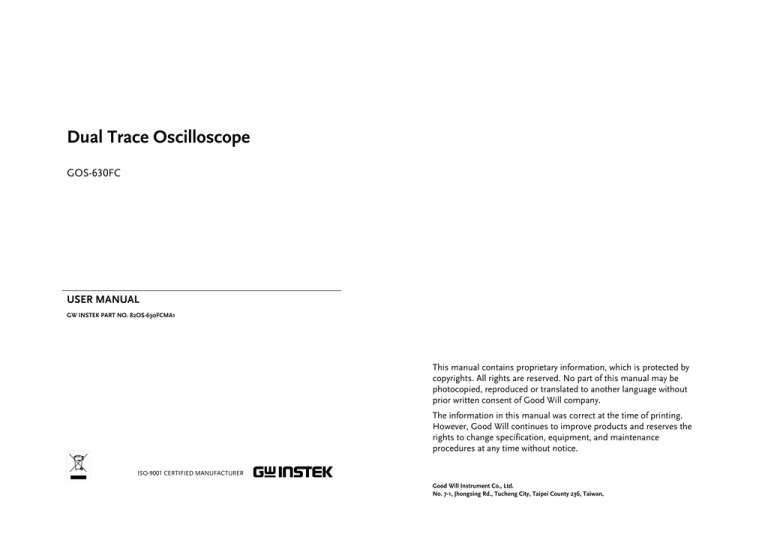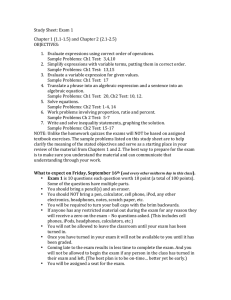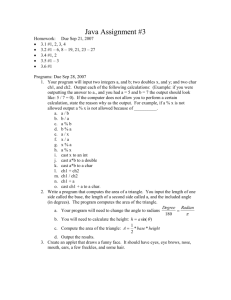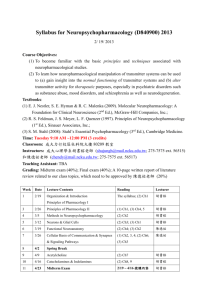
Dual Trace Oscilloscope
GOS-630FC
USER MANUAL
GW INSTEK PART NO. 82OS-630FCMA1
This manual contains proprietary information, which is protected by
copyrights. All rights are reserved. No part of this manual may be
photocopied, reproduced or translated to another language without
prior written consent of Good Will company.
The information in this manual was correct at the time of printing.
However, Good Will continues to improve products and reserves the
rights to change specification, equipment, and maintenance
procedures at any time without notice.
ISO-9001 CERTIFIED MANUFACTURER
Good Will Instrument Co., Ltd.
No. 7-1, Jhongsing Rd., Tucheng City, Taipei County 236, Taiwan.
TABLE OF CONTENTS
Table of Contents
SAFETY INSTRUCTIONS ................................................... 5
PRODUCT OVERVIEW ..................................................... 10
Product Description ............................. 10
Main Features ...................................... 11
Block Diagram ..................................... 12
PANEL OVERVIEW .......................................................... 13
Front Panel Overview ........................... 13
Display Controls .................................. 14
LCD Display ......................................... 15
Horizontal Controls ............................. 16
Vertical Controls .................................. 17
Trigger Controls ................................... 19
Input Terminals.................................... 22
Rear Panel Overview ............................ 23
SETUP............................................................................. 24
Default Settings ................................... 24
Set up & Probe Compensation ............. 26
MEASUREMENT.............................................................. 28
Single Channel (Basic) Measurement .. 28
Dual Channel Measurement................. 29
Waveform Addition/Subtraction ........... 31
Frequency Measurement ...................... 31
X-Y Mode ............................................. 32
Waveform Magnification ...................... 33
FAQ ................................................................................ 34
3
GOS-630FC User Manual
APPENDIX ...................................................................... 36
Line Voltage & Fuse Replacement ........ 36
Specifications ...................................... 38
Declaration of Conformity .................... 40
SAFETY INSTRUCTIONS
GOS-630FC User Manual
Safety guidelines
SAFETY INSTRUCTIONS
General
•
Never connect a hazardous live voltage to the ground side of the BNC connectors. It might lead to fire or electric shock. •
Do not place heavy objects on the instrument. •
Avoid severe impacts or rough handlings that lead to damaging the instruments. •
Do not discharge static electricity onto the instruments. •
Use only mating connectors, not bare wires, for the terminals. •
Do not block the cooling fan opening. •
Do not perform measurements at power generating sources and building installation sites (See note below). •
Do not disassemble the instrument unless you are technically qualified. •
To prevent a permanent damage to the CRT phosphor, avoid excessively brightening the trace or holding a light spot for an unreasonably long time. •
Do not operate the instrument in a place where strong magnetic or electric field exists as it may disturb the measurement. •
Make sure the input voltage does not exceed the following values. Guideline
CAUTION
This chapter contains important safety instructions that you must follow when operating the instrument and when keeping it in storage. Read the following instructions before operating the instrument to ensure your safety and to keep it in best condition. Safety symbols
These safety symbols may appear in this manual or on the instrument. Warning: Identifies conditions or practices that WARNING
could result in injury or loss of life. CAUTION
Caution: Identifies conditions or practices that could result in damage to the instrument or to other properties. DANGER: High Voltage Attention: Refer to the Manual Protective Conductor Terminal Input Terminal
Maximum Input Voltage
CH1, CH2 input 300Vpeak Earth (Ground) Terminal EXT TRIG input 300Vpeak 5
6
SAFETY INSTRUCTIONS
Probe input 600Vpeak Z AXIS input 30Vpeak GOS-630FC User Manual
Cleaning the
• Measurement category IV is for measurements performed at the
source of low-voltage installations.
• Measurement category III is for measurements performed in
building installations.
• Measurement category II is for measurements performed on the
circuits directly connected to low voltage installations.
Fuse
WARNING
•
Use a soft cloth dampened in a solution of mild detergent and water. Do not spray any liquid into the instrument. •
Do not use chemicals containing harsh products such as benzene, toluene, xylene, and acetone. Operation
•
Location: Indoor, no direct sunlight, dust free, almost non‐conductive pollution (See note below) Environment
• Measurement category I is for measurements performed on
circuits not directly connected to mains. WARNING
Disconnect the power cord before cleaning the instrument. instrument
(Measurement categories) EN 61010-1:2001 specifies the
measurement categories and their requirements as follows. The
GOS-630FC falls under category II.
Power Supply
•
•
AC Input voltage: 115V/230V AC, 50/60Hz •
Relative Humidity: < 85%, non‐condensing •
The power supply voltage should not fluctuate more than 15%. •
Altitude: < 2000m •
Temperature: 0°C to 40°C •
To avoid electric shock, connect the protective grounding conductor of the AC power cord to an earth ground. •
•
•
(Pollution Degree) EN 61010-1:2001 specifies the pollution degrees
and their requirements as follows. The GOS-630FC falls under
degree 2.
Pollution refers to “addition of foreign matter, solid, liquid, or
gaseous (ionized gases), that may produce a reduction of dielectric
strength or surface resistivity”.
Fuse type: T0.63A/250V (AC 115V), T0.315A/250V (AC230V) • Pollution degree 1: No pollution or only dry, non-conductive
pollution occurs. The pollution has no influence.
Make sure the correct type of fuse is installed before power up. • Pollution degree 2: Normally only non-conductive pollution
occurs. Occasionally, however, a temporary conductivity caused
by condensation must be expected.
To ensure fire protection, replace the fuse only with the specified type and rating. •
Disconnect the power cord before fuse replacement. •
Make sure the cause of fuse blowout is fixed before replacing the fuse. • Pollution degree 3: Conductive pollution occurs, or dry, nonconductive pollution occurs which becomes conductive due to
condensation which is expected. In such conditions, equipment
is normally protected against exposure to direct sunlight,
precipitation, and full wind pressure, but neither temperature
nor humidity is controlled.
Storage
environment
7
8
•
Location: Indoor •
Relative Humidity: < 70% •
Temperature: –10°C to 70°C SAFETY INSTRUCTIONS
Power cord for the United Kingdom
When using the instrument in the United Kingdom, make sure the power cord meets the following safety instructions. NOTE: This lead/appliance must only be wired by competent persons
WARNING: THIS APPLIANCE MUST BE EARTHED
IMPORTANT: The wires in this lead are coloured in accordance with the
Earth
Blue:
Neutral
Brown:
Live (Phase)
As the colours of the wires in mains leads may not correspond with the
colours marking identified in your plug/appliance, proceed as follows:
The wire which is coloured Green & Yellow must be connected to the Earth
terminal marked with the letter E or by the earth symbol
or Green & Yellow.
PRODUCT OVERVIEW
Product Description
following code:
Green/ Yellow:
GOS-630FC User Manual
or coloured Green
The wire which is coloured Blue must be connected to the terminal which is
marked with the letter N or coloured Blue or Black.
The wire which is coloured Brown must be connected to the terminal marked
The GOS‐630FC oscilloscope is a portable, dual‐channel oscilloscope. The GOS‐630FC provides maximum 30MHz DC bandwidth and 1mV/DIV sensitivity. Its time base reaches 0.2μS/DIV and the sweep speed 100nS/DIV. The GOS‐630FC uses a 6‐inch rectangular cathode ray tube display with red internal graticule. This is a sturdy, easy‐to‐
operate, and highly reliabile product. The GOS‐630FC also incorporates a separate LCD Display, which can show CH1/CH2 VOLT/DIV, TIME/DIV, X‐Y MODE, and Frequency. with the letter L or P or coloured Brown or Red.
If in doubt, consult the instructions provided with the equipment or contact
the supplier.
This cable/appliance should be protected by a suitably rated and approved
HBC mains fuse: refer to the rating information on the equipment and/or user
instructions for details. As a guide, cable of 0.75mm2 should be protected by
a 3A or 5A fuse. Larger conductors would normally require 13A types,
depending on the connection method used.
Any moulded mains connector that requires removal /replacement must be
destroyed by removal of any fuse & fuse carrier and disposed of immediately,
as a plug with bared wires is hazardous if a engaged in live socket. Any rewiring must be carried out in accordance with the information detailed on this
label.
9
10
PRODUCT OVERVIEW
Main Features
High intensity
and
acceleration
CRT
GOS-630FC User Manual
Block Diagram
The CRT incorporates high beam transmission, high intensity, and a 2kV high acceleration voltage. The CRT displays clearly readable traces even at higher sweep speeds. Wide
In addition to the DC‐30MHz (‐3dB) wide bandwidth and bandwidth, the oscilloscope provides a 1mV/DIV high sensitivity. The 30MHz frequency range is sensitivity
obtained by an improved triggering synchronization. Frequency
A built‐in 5‐digit frequency counter offers ±0.02% accuracy between 1kHz and 30MHz, and ±0.05% between 50Hz and 1kHz. Automatic
Pressing the AUTO TIMEBASE key automatically adjusts the sweep time to an appropriate range. Counter
timebase
adjustment
Alternate
Even when observing two waveforms in different frequencies, both waveforms can be stably triggered using the alternate triggering mode. TV sync
The oscilloscope has a sync separator circuit for the TV‐V and TV‐H signal triggering. CH1 output
The CH1 signal is output from a rear panel terminal, which can be applied to external devices.
Z-axis input
Display intensity can be controlled via the TTL compatible z‐axis input on the rear panel. X-Y mode
The X‐Y mode compares the CH1 and CH2 signal amplitude. It is useful for comparing the phase difference. Buzzer alarm
Incorrect operation generates a warning beep. triggering
triggering:
11
12
PANEL OVERVIEW
GOS-630FC User Manual
Vertical
Controls the vertical scale, vertical position, display mode, CH2 inversion, and alternate display mode. Trigger
Controls the trigger mode, trigger level, trigger coupling source, trigger slope, and alternate triggering mode. Accepts the external trigger input. Input
Accepts the CH1 and CH2 input signals and ground wire. Controls the input signal coupling mode. Controls
PANEL OVERVIEW
Controls
Terminals
Front Panel Overview
Display Controls
1
2
3
4
5
6
1 CAL Output Generates the probe compensation signal; 2Vp‐p, 1kHz, positive square wave. For probe compensation details, see page26. 2 INTEN Knob Controls the brightness of a light spot or trace in the display. Detailed descriptions of each block start from the next page. 3 FOCUS
Main Display Shows the waveforms of input signals. 4 TRACE
Display
Controls
LCD Display
Horizontal
Controls
Knob
Controls the alignment of the horizontal trace in ROTATION parallel with graticule lines. Controls power on/off, display configuration, and the probe compensation output. Point
5 AUTO
Shows the vertical scale, horizontal scale, X‐Y display mode, and waveform frequencies. TIMEBASE
Controls the horizontal scale, horizontal position, sweep length, and x10 magnification. Automatically adjusts the horizontal scale to an appropriate range according to the input signal. Key
6 POWER
Switch
13
Controls the focus (sharpness) of the waveforms in the display. 14
Turns on or off the oscilloscope’s main power. When the power is on, the LED lights. PANEL OVERVIEW
GOS-630FC User Manual
LCD Display
Horizontal Controls
1 CH1
1 Horizontal Controls the horizontal position of traces and light POSITION spots. Shows the CH1 vertical scale. Vertical
Knob
Scale
2 Horizontal Shows the horizontal scale. 3 X-Y Mode
4 Signal
Shows the waveform frequency. For frequency measurement details, see page31. 5 CH2
Shows the CH2 vertical scale. Frequency
Magnifies the horizontal scale by a factor of 10. For horizontal magnification details, see page33. 3 SWP VAR
Adjusts the horizontal scale. Switch
Scale
When turned on, indicates that the X‐Y mode is activated. For X‐Y mode details, see page32. 2 ×10 MAG
Knob
At the minimum position, the horizontal scale becomes 2.5 times wider than the original value selected by the TIME/DIV knob. For example, if the original scale is 1mS/DIV, the adjusted scale becomes 2.5mS/DIV. At the maximum (CAL) position, there is no change in the horizontal scale. Vertical
Scale
4 TIME/DIV
Knob
Controls the horizontal scale from 0.2 μs/div to 0.5 s/div in 20 steps. When “X‐Y” is selected, the oscilloscope works in the X‐Y mode. For X‐Y mode details, see page32. 15
16
PANEL OVERVIEW
GOS-630FC User Manual
Vertical Controls
5 VAR Knob
1
2
3
4
5
POSITION
6
ADD The CH1 and CH2 signals are added or subtracted, and then the result is displayed. For CH1/CH2 addition/subtraction details, see page31. Adjusts the vertical scale. At the maximum (CAL) position, there is no change in the vertical scale. 6 CH2 INV
Controls the vertical position of traces and light spots for CH1/CH2. Switch
Knob
3 ALT/CHOP Selects how the CH1 and CH2 signals appear in the display, in the DUAL trace mode. Switch
4 Vertical
The CH1 and CH2 signals are displayed simultaneously. At the minimum position, the vertical scale becomes 2.5 times wider than the original value selected by the VOLTS/DIV knob. For example, if the original scale is 1mV/DIV, the adjusted scale becomes 2.5mV/DIV. 1 VOLTS/DIV Controls the CH1/CH2 vertical scale from 1mV/DIV to 5V/DIV in 12 steps. Knob
2 Vertical
DUAL CHOP
The two signals are chopped and displayed simultaneously (generally used in slow sweep, 1ms/DIV or slower). ALT
The two signals are displayed alternatively (generally used in fast sweep, 0.5ms/DIV or faster). Selects CH1 and CH2 display modes. MODE
Switch
CH1/CH2 The CH1 or CH2 signal is displayed independently. 17
18
Inverts the CH2 input signal vertically. When the vertical mode switch is in the ADD position, CH2 is subtracted from CH1 instead of being added to CH1. For CH1/CH2 addition/subtraction details, see page31. PANEL OVERVIEW
GOS-630FC User Manual
Trigger Controls
1 Trigger ALT When pressed, the TRIG ALT switch constantly toggles the trigger source between CH1 and CH2 Switch
signal, so that both signals can be clearly viewed. TV-V
The oscilloscope triggers when a vertical video synchronization signal appears. For triggering on the field, select 2ms/DIV as the horizontal scale; for triggering on the frame (two interlaced fields), 5ms/DIV. TV-H
The oscilloscope triggers when a horizontal video synchronization signal appears. For triggering on the line, select 10us/DIV as the horizontal scale. Use the SWP VAR knob to control the number of waveforms. Note
•
For TV‐V and TV‐H trigger, the oscilloscope responds only to negative polarity signals. The TRIG ALT switch works when the vertical mode is in the DUAL position and also the trigger source is in the CH1 or CH2 position. Note
2 Trigger
MODE
•
The TRIG ALT switch does not work when the ALT/CHOP switch is in the CHOP position. •
The frequency counter in the LCD display does not work when the TRIG ALT switch is pressed. •
3 Trigger
Switch
The oscilloscope sweeps regardless of the existence of trigger conditions. NORM
The oscilloscope sweeps only when a trigger condition occurs. 19
Changes the trigger level vertically. LEVEL Knob The trigger level moves up when the trigger LEVEL knob is turned clockwise. The TRIGGER MODE switch selects when the oscilloscope responds to the trigger conditions. AUTO
The oscilloscope cannot trigger input signals when their frequencies are less than 25Hz. The trigger level moves down when the trigger LEVEL knob is turned counterclockwise. 20
PANEL OVERVIEW
4 Trigger
SLOPE
Switch
Selects the triggering slope. When in the “+” position (
), the oscilloscope triggers when the positive slope of the trigger source signal crosses the trigger level. GOS-630FC User Manual
Input Terminals
When in the “–” position (
), the oscilloscope triggers when the negative slope of the trigger source signal crosses the trigger level. 1 CH 1 (X)
Input
Accepts the CH1 input signal. In X‐Y mode, the CH1 input signal becomes the X‐axis. Terminal
2 AC/GND/
5 Trigger
Selects the signal on which the oscilloscope sweeps.
SOURCE
Switch
CH1 CH1 signal becomes the trigger source. CH2 CH2 signal becomes the trigger source. LINE EXT 6 TRIG IN
Terminal
Selects the coupling mode for the input signal. DC Switch
AC power line signal becomes the trigger source. Useful when the input signal synchronizes with the power line frequency. The external trigger input (TRIG IN terminal) signal becomes the trigger source. Accepts an external trigger source signal. The signal becomes active when the trigger SOURCE switch is in the EXT position. The oscilloscope block DC components included in the input signal. GND
Shows the ground (zero volt) level on the display. This mode is only for checking the reference level; input signal does not appear on the display. DC
The oscilloscope displays all of the input signal. 3 GND
Accepts a ground wire. The GND terminal is connected to the oscilloscope mainframe. 4 CH 2 (Y)
Accepts the CH2 input signal. In X‐Y mode, the CH2 input signal becomes the Y‐axis. Terminal
Input
Terminal
•
Input impedance: 1MΩ // 25pF 21
AC
22
For X‐Y mode details, see page32. PANEL OVERVIEW
Rear Panel Overview
GOS-630FC User Manual
SETUP
Default Settings
Before powering up the oscilloscope, set up the front panel as follows. 1
2
3
4
1 FUSE & Line Holds the AC mains fuse and selects the AC line voltage, 115V or 230V. Voltage
Selector
2 AC Power
Accepts the AC power cord. Input
Connector
3 CH1
OUTPUT
INPUT
Terminal
•
Off INTEN Knob
Center FOCUS Knob
Center Vertical MODE
CH1 ALT/CHOP
ALT (
CH 2 INV
Released (Inversion disabled) CH1/CH2
Center of the display Switch
Outputs the CH1 signal; approximately 20mV/DIV when terminated with 50Ω. Terminal
4 Z AXIS
POWER Switch
Accepts an external intensity modulation (Z‐axis) signal; 1kHz square wave, DC – 2MHz. Positive going reduces intensity. For detailed specifications, see page38. For AC line voltage selection and fuse replacement, see page36. Switch
Switch
Vertical
POSITION
Knob
CH1/CH2
VOLTS/DIV
Knob
23
) 24
50mV/DIV SETUP
CH1/CH2
CAL Set up & Probe Compensation
VARIABLE
Knob
CH1/CH2
GOS-630FC User Manual
Follow these steps and properly set up the oscilloscope, make sure it is functional, and compensate the probe. AC Coupling
Trigger
CH1 Trigger SLOPE
+ (Positive slope) TRIG ALT
Switch
Released (alternating trigger disabled) Trigger MODE
AUTO 1
Power on
2
Intensity
3
Probe
4
Probe
Select x10 (attenuation) on the probe. 5
Coupling
Select the AC position in the CH1 AC‐DC‐GND switch. A square waveform appears in the display. SOURCE Switch
Switch
Switch
TIME/DIV
0.5ms/DIV Knob
Horizontal
CAL Horizontal
Center of the display Press the Power switch and turn on the oscilloscope’s power. The LED lights when the power is on. The trace line starts to appear after 20 – 30 seconds. Use the INTEN knob and FOCUS knob to adjust the trace line and focus
adjustment appearance to the best condition. Connect the probe between the connection CAL output and the CH1 input terminal. Select x10 (attenuation) on the probe. attenuation
x1
x10
Switch
SWP.VAR Knob
POSITION
mode
Knob
x10 MAG
Switch
selection
Released (x10 maginification disabled) 25
26
SETUP
6
Vertical
7
Horizontal
Use the CH1 VOLTS/DIV knob adjustment and CH1 vertical POSITION knob to adjust the vertical scale and position of the waveform. GOS-630FC User Manual
MEASUREMENT
Use the CH1 TIME/DIV knob and adjustment CH1 horizontal POSITION knob to adjust the horizontal scale and position of the waveform. Single Channel (Basic) Measurement
Steps
8
Probe
Adjust the compensation point on the probe so compensa- that the waveform becomes square. 2. Select the vertical coupling between AC (DC components are blocked) or DC (all signal components appear). tion
Under compensation
Right amount
1. Connect the input signal to the CH1 or CH2 terminal. 3. Configure the trigger settings. For details, see page19. Over compensation
4. Use the VOLTS/DIV knob and vertical POSITION knob to adjust the vertical scale and position of the waveform. 9
5. Press the AUTO TIMEBASE key to automatically adjust the horizontal scale according to the input signal. Completion Now setting up the oscilloscope is completed. For more advanced measurements, see page28. 6. If necessary, use the TIME/DIV knob to adjust the horizontal scale manually. Use the horizontal POSITION knob to adjust the position of the waveform. 27
28
MEASUREMENT
GOS-630FC User Manual
6. Use the vertical ALT/CHOP switch to select how the two waveform appear on the display: alternately (ALT mode) or simultanouesly (CHOP mode). See page17 for details. Dual Channel Measurement
Steps
1. Connect both CH1 and CH2 signals to the input terminals. 2. Select the vertical coupling between AC (DC components are blocked) or DC (all signal components appear) for both channels. 7. If necessary, use the VOLTS/DIV knob and vertical POSITION knob to adjust the vertical scale and position of the waveform. 3. Configure the trigger settings. For details, see page19. Make sure the trigger SOURCE switch is in either the CH1 or CH2 position. 8. If necessary, use the TIME/DIV knob and horizontal POSITION knob to adjust the horizontal scale and position of the waveform. 4. Set the vertical MODE switch to the DUAL position. Note
5. Both the CH1 and CH2 signals appear on the display. 29
30
The trigger ALT switch does not work when the ALT/CHOP switch is in the CHOP position. MEASUREMENT
GOS-630FC User Manual
Waveform Addition/Subtraction
X-Y Mode
Steps
Background
The X‐Y mode compares the amplitude of two signals (CH1 and CH2), one as X‐axis (CH1) and the other as Y‐axis (CH2). The X‐Y mode is useful for measuring the phase difference of two signals, video color patterns, and frequency response. Steps
1. Make sure both CH1 and CH2 waveforms appear on the display. For details, see page29. 1. Make sure both CH1 and CH2 waveforms appear on the display. For details, see page29. 2. Set the vertical MODE switch to the ADD position. The two waveforms are added and appear on the display as a single waveform. 2. Move the TIME/DIV knob to the X‐Y position. 3. To subtract the CH2 signal from the CH1 signal, invert the CH2 signal by pressing the CH2 INV switch. 3. The CH1 and CH2 signals appear in the X‐Y mode and the X‐Y indicator in the LCD display ( X‐Y ) turns on. Frequency Measurement
Frequency
shown on the
The frequency of the input signal appears on the LCD display and is constantly updated. LCD
Frequency
measurement
using the CH1
output
The CH1 signal frequency can be measured using an external device such as frequency counter, via the rear panel terminal. 4. To adjust the X‐axis position and deflection, use the horizontal POSITION knob (position) and CH1 VOLTS/DIV knob (deflection). 31
32
MEASUREMENT
5. To adjust the Y‐axis position and deflection, use the CH2 vertical POSITION knob (position) and CH2 VOLTS/DIV knob (deflection). FAQ
Waveform Magnification
Background
Steps
GOS-630FC User Manual
The oscilloscope can magnify the waveform by ten times in the horizontal direction. The magnification is useful for observing complex signals. 1. Make sure the waveform is shown on the display. The probe waveform is distorted.
You might need to compensate the probe. For details, see page26. Note that frequency accuracy and duty factor are not specified for the probe compensation waveform and therefore it should not be used for reference purpose. The trace line does not appear on the display.
2. Press the ×10 MAG switch. The waveform becomes magnified by ten times in the horizontal direction. Make sure that the trigger mode is in the AUTO mode. In the NORMAL mode, the trace does not appear unless a trigger condition occurs. x10 magnification
The alternate trigger (TRIG ALT switch) does not work.
Make sure that the ALT/CHOP switch is released (ALT position). The TRIG ALT switch does not work in the CHOP mode. The frequency counter in the LCD display does not work.
Make sure that the TRIG ALT switch is not pressed. The frequency counter does not work in the alternate trigger mode. The TV trigger does not work.
Any part can be covered by using the POSITION control
Make sure that the video synchronization signal is positive. The TV‐
V/TV‐H trigger works only when the synchronization signal is negative. 33
34
FAQ
The input signal does not appear on the display.
Check the following settings. •
The coupling mode is not set at the GND mode, in which the waveform does not appear on the display. See page22 for details. •
The appropriate trigger source is selected. See page19 for details. The oscilloscope accuracy does not match the specifications.
Make sure the oscilloscope is powered on for at least 30 minutes, within +20°C – +30°C. This is necessary to stabilize the oscilloscope. GOS-630FC User Manual
APPENDIX
Line Voltage & Fuse Replacement
1. Take off the power cord. For more information, contact your local dealer, Good Will Instruments website www.gwinstek.com.tw, or marketing@goodwill.com.tw. 115
230
2. Use a small minus driver and pull out the fuse socket. 115
230
3. Rotate the holder so that the target voltage marking moves to the upper side. AC115V
230
36
230
230
35
115
115
115
AC230V
APPENDIX
4. If necessary, replace the fuse that is attached to the fuse holder. GOS-630FC User Manual
Specifications
The specifications apply when the GOS‐630FC is powered on for at least 30 minutes under +20°C – +30°C. 115
Vertical
Sensitivity
5mV/DIV to 5V/DIV: ±3%
Bandwidth
1mV/DIV to 2mV/DIV: DC to 7MHz
230
5mV/DIV to 5V/DIV: DC to 30MHz
5. Push the fuse holder back into the socket. AC coupling
Rise time
Input impedance
230
115
Fuse rating
1mV/DIV to 2mV/DIV: ±5%
accuracy
AC 115V: T0.63A/250V, AC 230V: T0.315A/250V > 10Hz (reference: 100kHz, 8DIV, –3dB)
1mV/DIV to 2mV/DIV: Approx. 50nS
5mV/DIV to 5V/DIV: Approx. 11.7nS
Approx. 1M ohm // 25pF.
Square wave
≤ 5% Overshoot at 10mV/DIV
characteristics
Linearity
Other ranges: 5% added to the above
±0.1DIV when moving 2 DIV at center
Vertical mode
CH1, CH2, DUAL, ADD
Chop frequency
Approx. 250kHz
Input coupling
AC, GND, DC
Max input voltage CAT II 300Vpeak (AC: ≤ 1kHz)
Max effective
Probe1:1 40Vpp (14Vrms Sine wave)
readout
Probe10:1 400Vpp (140Vrms Sine wave)
Common mode
≥ 50:1 at 50kHz sine wave
rejection ratio
(CH1 and CH2 vertical scales are equal)
Channel isolation >1000:1 at 50kHz
@ 5mV/DIV
>30:1 at 30MHz
CH1 signal output ≥ 20 mV/DIV @ 50Ω, 50Hz to 5MHz
Trigger
CH2 INV BAL.
≤1 DIV (Reference at center graticule)
Trigger source
CH1, CH2, LINE, EXT
Coupling
AC: 20Hz to full bandwidth
Slope
+/-
Sensitivity
20Hz to 2MHz : 0.5 DIV
(TRIG-ALT:2 DIV, EXT: 200mV)
2MHz to 30MHz: 1.5 DIV
(TRIG-ALT:3 DIV, EXT: 800mV)
TV: Sync pulse > 1 DIV (EXT: 1V)
Triggering modes AUTO, NORM, TV-V, TV-H
EXT TRIG input
Input impedance: Approx.:1MΩ // 25pF
Max. input: CAT II 300Vpeak < 1kHz
37
38
APPENDIX
Horizontal Axis
Sweep time
0.2µS to 0.5S/DIV, ±3%
accuracy
x10MAG accuracy ±5% (20/50nS uncalibrated)
±3%, x10:±5% (20/50nS uncalibrated)
Linearity
X-Y Mode
Sensitivity
Same as vertical axis
Bandwidth
DC to at least 500kHz
Phase Difference
Z-Axis
≤3 degrees at DC to 50kHz
Sensitivity
5Vpp (Positive going reduces intensity)
Bandwidth
DC to 2MHz
Input resistance
Approx. 47kΩ
Probe
Waveform
Positive-going square wave
Compensation
Frequency
Approx. 1 kHz
Signal
Duty Ratio
Output voltage
Within 48:52
2 Vp-p ±2%.
Frequency
Display Digits
Maximum 5 digit decimal
Counter
Frequency Range 50Hz to 30MHz
50Hz to 1kHz: ±0.05%
Accuracy
Max input voltage CAT II 30Vpeak (AC ≤1kHz)
Output impedance Approx. 1 kΩ
GOS-630FC User Manual
Declaration of Conformity
We
GOOD WILL INSTRUMENT CO., LTD.
(1) No.7-1, Jhongsing Rd., Tucheng City, Taipei County, Taiwan
(2) No. 69, Lu San Road, Suzhou City (Xin Qu), Jiangsu Sheng, China
declare, that the below mentioned product
Type of Product: Oscilloscope
Model Number: GOS-630FC
are herewith confirmed to comply with the requirements set out in the
Council Directive on the Approximation of the Law of Member States
relating to Electromagnetic Compatibility (2004/108/EC, 92/31/EEC,
93/68/EEC) and Low Voltage Directive (2006/95/EC).
For the evaluation regarding the Electromagnetic Compatibility and
Low Voltage Directive, the following standards were applied:
◎ EMC
EN 61326-1: Electrical equipment for measurement, control and laboratory
use –– EMC requirements (2006)
Maximum operating range: 0℃ to 40℃ (32°F to 104°F)
Conducted Emission
Radiated Emission
EN 55011: 1998 + A1:1999 +
A2:2002, ClassB
Current Harmonics
EN 61000-3-2: 2000 + A2:2005
Voltage Fluctuations
EN 61000-3-3: 1995 + A1: 2001
+A2: 2005
Electrostatic Discharge
EN 61000-4-2: 1995 + A1:1998 +
A2:2001
Radiated Immunity
EN 61000-4-3: 2002 + A1:2002
◎ Safety
Relative humidity: 85% RH(max.) non-condensing
Low Voltage Equipment Directive 2006/95/EC
1kHz to 30MHz: ±0.02%
Sensitivity
> 2DIV
LCD
Display
VOLT/DIV, TIME/DIV, X-Y, Frequency
Backlight
Orange
CRT
Type
6-inch rectangular, internal graticule
Phosphor
P 31
Acceleration Volt. Approx. 2kV
8 × 10 DIV (1 DIV = 10mm (0.39in))
Screen Size
Power Source
AC115V/230V±15%, 50/60Hz
Power
Approx. 40VA, 35W(max.)
Operation
Indoor use, Altitude ≤ 2000 m
Environment
Ambient temperature :
To satisfy specifications:10℃ to 35℃ (50°F to 95°F)
Safety Requirements
IEC/EN 61010-1: 2001
Installation Category II, Pollution degree 2
Storage
Ambient temperature: -10℃ to 70℃
Environment
Relative humidity: 70%RH (maximum)
Accessories
Power cord x 1, User manual x 1, Probe x 2
Dimensions
310 (W) x 150 (H) x 455 (D) mm
Weight
Approx.8.2kgs (18.0lbs)
39
40
Electrical Fast Transients
EN 61000-4-4: 2004
Surge Immunity
EN 61000-4-5: 1995 + A1:2001
Conducted Susceptibility
EN 61000-4-6: 1996 + A1:2001
Power Frequency Magnetic Field
EN 61000-4-8: 1993 + A1:2001
Voltage Dip/ Interruption
EN 61000-4-11: 2004








